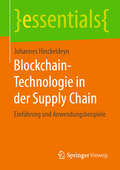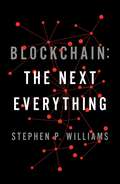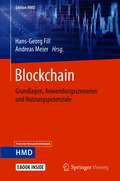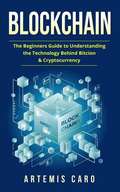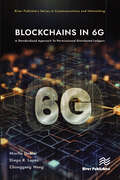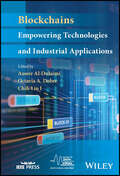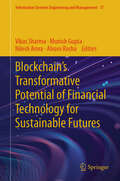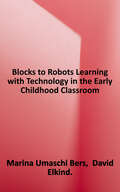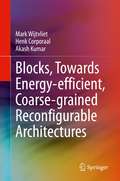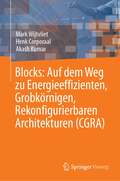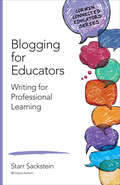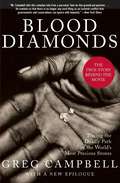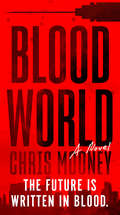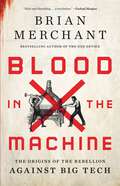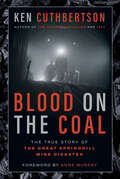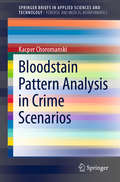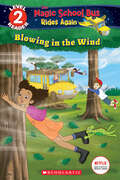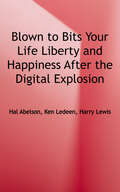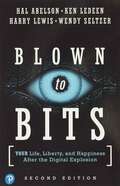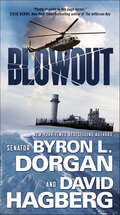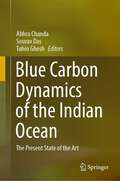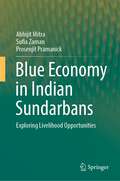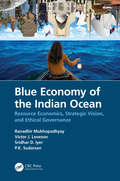- Table View
- List View
Blockchain-Technologie in der Supply Chain: Einführung und Anwendungsbeispiele (essentials)
by Johannes HinckeldeynSeit der Einführung des Bitcoin hat die zugrunde liegende Blockchain steigende Aufmerksamkeit erfahren, begründet durch das hohe Maß an Manipulationssicherheit dieser Technologie. Als wichtiges Anwendungsfeld für Blockchain wird dabei häufig die Lieferkette von Unternehmen genannt. Johannes Hinckeldeyn gibt in diesem essential eine Einführung in die Blockchain-Technologie mit besonderem Fokus auf Logistik und Lieferkette. Er stellt verschiedene Blockchains und System-Architekturen vor, diskutiert – basierend auf realen Projekten – generische Anwendungsfälle und leitet Empfehlungen ab.
Blockchain: A Short Guide To Blockchain
by Stephen P. WilliamsAn experienced tech writer fully explains blockchain technology and how it will radically transform the world as we know it in this accessible, reader-friendly, illuminating guide.What is blockchain? Why does everyone from tech experts to business moguls to philanthropists believe it is a paradigm-shifting technology, bound to revolutionize society as significantly as the internet? Indeed, why is blockchain touted as The Next Everything? In this deft, fascinating, and easy-to-digest introduction to one of the most important innovations of recent times, Stephen P. Williams answers these questions, revealing how cryptocurrencies like bitcoin are just one example among dozens of transformative applications that this relatively new technology makes possible. He interprets the complexity into digestible anecdotes, metaphors, and straightforward descriptions for readers who don’t know tech, and explains all of blockchain’s most important aspects: why this so-called digital ledger is unhackable and unchangeable; how its distributed nature may transfer power from central entities like banks, government, and corporations to ordinary citizens around the world; and what its widespread use will mean for society as a whole. Taking us on a dazzlingly vivid tour through the systems predicted to soon underpin economics, politics, global trade, science, art, and numerous other aspects of our everyday lives, Blockchain: The Next Everything is a truly extraordinary journey into our future.
Blockchain: Grundlagen, Anwendungsszenarien und Nutzungspotenziale (Edition HMD)
by Andreas Meier Hans-Georg FillSowohl in der Praxis als auch der wissenschaftlichen Forschung ist das Thema "Blockchain" aktuell von großem Interesse. Noch scheint sich die Technologie am Anfang ihrer Entwicklung zu befinden: Plattformen wie Bitcoin, Ethereum, Hyperledger Fabric, Libra, TradeLens oder andere weisen bereits einen beeindruckenden Reifegrad in ihrer technischen Entwicklung auf. Dennoch befinden sich erst wenige von ihnen bzw. darauf aufbauende Applikationen im produktiven Einsatz bei Unternehmen. Hier können nicht nur Forschende optimal dazu beitragen, neue Ideen zu entwickeln, noch nicht betrachtete Anwendungsfälle und -domänen zu untersuchen und erste Prototypen für den konkreten Einsatz zu entwickeln. Die Beiträge der vorliegenden Edition HMD bieten dazu einen umfassenden Überblick und zeigen die große Bandbreite an möglichen Anwendungsfeldern für Blockchains. Das Herausgeberwerk vermittelt somit die Grundlagen zur Blockchain-Technologie, widmet sich den Smart Contracts und beschreibt wichtige Anwendungsszenarien, erste Fallbeispiele und rechtliche Aspekte. Wie typisch für die Fachbuchreihe Edition HMD greifen die Beitragsautoren das Thema aus Sicht von Forschung und Praxis gleichermaßen auf. Ein Glossar mit den wichtigsten Begriffen rundet das Buch ab.
Blockchain: The Beginners Guide To Understanding The Technology Behind Bitcoin And Cryptocurrency
by Artemis CaroCryptocurrency and it's disruptive architecture, Blockchain, is now making the biggest revolution in the Finance sector for the last 100 years. There is a lot of hype surrounding the concept of the blockchain, but what does this term actually mean? What is blockchain technology? Why does it matter? These questions are not always answered with due diligence in the sea of headlines that deal with digital currencies using blockchains. As a result, many people are left with an incomplete understanding of this transformative new technology and its massive implications for the future. The goal of this book is not to plumb the depths of the mathematical wizardry used to code blockchain-based applications, but rather to serve as an introduction to the broader architecture and conceptual background behind blockchain technology. We will take a practical approach, examining how Blockchains are used in the real world. In this short, concise guide you will learn: A Brief History of Blockchain Technology Blockchain Basics: Managing Digital Transactions What is a Distributed Ledger? Blockchain Beyond Bitcoin Implications Of Blockchain: Big Data, Privacy & Personal Data Profiting from Blockchain Technologies Limitations & Challenges of Blockchain The Future of Blockchain For Centuries, people have relied on corrupt Centralized Institutions like banks and Governments to serve as intermediaries when it comes to storing and transacting financial assets.
Blockchains in 6G: A Standardized Approach To Permissioned Distributed Ledgers (River Publishers Series in Communications and Networking)
by Chonggang Wang Mischa Dohler Diego R. LopezBased on work done within ETSI, this comprehensive guide dives deep into the heart of blockchains and their imminent intersection with 6G. Whether you're a tech enthusiast or an industry expert, this book promises to enlighten, engage, and inspire, drawing you into the exciting intersection of 6G and blockchains.Part I - Blockchain Enablers: Embark on a foundational journey through blockchains, unraveling their basic principles and complex mechanics. From understanding the rudiments of blockchains to exploring the nuances of smart contracts, this section elucidates the pivotal aspects that make blockchains tick. Learn about the necessity for scalability, interoperability, and the crucial role of permissioned distributed ledgers.Part II - Blockchain Ecosystem: Delve into the underpinnings that form the blockchain ecosystem. This segment demystifies the governance and technical standards that guide blockchains and touches upon the alliances formed in its name. As an essential addition, it delves into the regulatory landscape and the critical R&D projects pushing blockchain boundaries.Part III - Blockchain Standards: Setting a benchmark for quality and reliability, this part deciphers the ETSI standards work governing blockchains. Understand the governance of permissioned distributed ledger (PDL) applications, explore reference architectures, and comprehend the role of smart contracts. Data management in a distributed setup and the intricacies of offline operations are neatly detailed, followed by a deep dive into the challenges and solutions for ledger interoperability.Part IV - Blockchains in 6G: The last part of the book bridges the vast world of blockchains with the frontier of 6G telecommunication systems. Commencing with an introduction to the predecessors of 6G, it then charts the course for blockchains' role in 6G data sharing and the radio access network, as well as the emerging topic of the metaverse.
Blockchains: Empowering Technologies and Industrial Applications (IEEE Series on Digital & Mobile Communication)
by Anwer Al-Dulaimi Octavia A. Dobre Chih-Lin IBlockchains Empowering Technologies and Industrial Applications A comprehensive guide to the most recent developments in blockchains in theoretical and industrial perspectives Originally introduced as a method to keep track of Bitcoin transactions over a peer-to-peer network, blockchain is a continuously growing list of records, called blocks, which are linked and secured using cryptography into a chain held in public databases. The use of this technology has grown since its cryptocurrency creation and now store three types of information: 1) transactions, including the date, time, and value of purchases; 2) records of participates in transactions; and 3) unique code known as a “hash” that distinguishes one block from another. A single block on the blockchain can hold 1 MB of data, or potentially thousands of transactions — this then can allow for hundreds of thousands of transactions to be recorded as each block can join the state-of-the-art blockchain. Blockchains provides a detailed overview of the latest and most innovative concepts, techniques, and applications related to the developing blockchain. Aimed at novices and experts on the subject, the book focuses on blockchain technologies, integrated systems, and use cases, specifically by looking at three major technical areas: blockchain platforms and distributed database technologies, consensus and fault tolerance, and Blockchain as a Service (BaaS). These avenues of research are essential to support blockchain functionalities, such as acquiring and updating existing data, securing data resources and the recovery of failures, and using blockchains in various services that range from cryptocurrencies to cloud automation. Blockchains readers will also find: Brainstorming activities that gradually builds the knowledge of readers on the described technology and deployment scenarios Investigation of specific topics such as novel networking protocols, wireless techniques, new infrastructure designs, operations management, and deployment strategies Discussion of technical challenges in blockchain, as well as how to manage cloud-based networks, service automation, and cyber security Numerous elementary and advanced examples on various topics at the end of the book that can be used for training purposes Illustrations including tables and diagrams to help elucidate points made throughout the volume Glossary of relevant terminology to blockchains in enterprise Blockchains is a useful reference for researchers in vehicular networking and computer science, as well as cloud storage providers and governmental offices for data management.
Blockchain’s Transformative Potential of Financial Technology for Sustainable Futures (Information Systems Engineering and Management #17)
by Alvaro Rocha Vikas Sharma Munish Gupta Nilesh Arora"Blockchain's Transformative Potential of Financial Technology for Sustainable Futures" delves into the groundbreaking impact of blockchain technology on the financial sector, highlighting its potential to foster sustainable development. This comprehensive volume brings together a diverse array of experts who explore how blockchain can revolutionize financial technology (FinTech) by enhancing transparency, efficiency, and inclusivity. The book examines blockchain's role in promoting financial inclusion, providing secure and accessible financial services to underserved populations. By bridging gaps in the current financial system, blockchain empowers individuals and communities, driving economic growth and resilience. Additionally, it addresses the environmental benefits of blockchain, showcasing innovative solutions like decentralized energy markets and transparent supply chains that contribute to sustainability. Readers will gain insights into real-world applications of blockchain, supported by case studies and in-depth analyses. The book also navigates the complex regulatory and ethical landscape, offering guidance on harnessing blockchain's potential responsibly. "Blockchain's Transformative Potential of Financial Technology for Sustainable Futures" is an essential resource for professionals, researchers, and policymakers interested in the future of FinTech and sustainable development. It serves as a catalyst for further research, dialogue, and collaboration, inspiring a new era of financial innovation and sustainability.
Blocks to Robots: Learning with Technology in the Early Childhood Classroom
by Marina Umaschi BersResearch shows that attitudes about science, math, and technology start to form during the early schooling years. This pioneering book shows how to successfully use technology in the early childhood classroom. Grounded in a constructivist approach to teaching and learning, the author focuses on robotic manipulatives that allow children to explore complex concepts in a concrete and fun way. At the same time, she examines how this technology engages sensorimotor and socioemotional skills, which are fundamental for the healthy development of young children. This innovative book: - Provides examples of how robotics can be a powerful, hands-on tool for young children to learn about science, technology, engineering, and math (STEM). - Presents portraits of children developing the skills and ways of thinking needed to create their own personally meaningful projects, and to solve problems using technology. - Offers sample curriculum starter activities, including forms and charts that children can use to chronicle the progress of their projects. - Includes vignettes of diverse curricular experiences by teachers and researchers working in classrooms.
Blocks, Towards Energy-efficient, Coarse-grained Reconfigurable Architectures
by Henk Corporaal Akash Kumar Mark WijtvlietThis book describes a new, coarse-grained reconfigurable architecture (CGRA), called Blocks, and puts it in the context of computer architectures, and in particular of other CGRAs. The book starts with an extensive evaluation of historic and existing CGRAs and their strengths and weaknesses. This also leads to a better understanding and new definition of what distinguishes CGRAs from other architectural approaches. The authors introduce Blocks as unique due to its separate programmable control and data paths, allowing light-weight instruction decode units to be arbitrarily connected to one or more functional units (FUs) over a statically configured interconnect. The discussion includes an explanation of how to model architectures, resulting in an area and energy model for Blocks. The accuracy of this model is evaluated against fully implemented architectures, showing that although it is three orders of magnitude faster than synthesis the error margin is very acceptable. The book concludes with a case study on a real System-on-Chip, including a RISC architecture, the Blocks CGRA and peripherals.
Blocks: Auf dem Weg zu Energieeffizienten, Grobkörnigen, Rekonfigurierbaren Architekturen (CGRA)
by Henk Corporaal Akash Kumar Mark WijtvlietDieses Buch beschreibt eine neue, grobkörnige rekonfigurierbare Architektur (CGRA), genannt Blocks, und stellt sie in den Kontext von Computerarchitekturen und insbesondere von anderen CGRAs. Das Buch beginnt mit einer ausführlichen Bewertung historischer und bestehender CGRAs und deren Stärken und Schwächen. Dies führt auch zu einem besseren Verständnis und einer neuen Definition dessen, was CGRAs von anderen Architekturansätzen unterscheidet. Die Autoren stellen Blocks als einzigartig vor, da es über separate programmierbare Steuer- und Datenpfade verfügt, so dass leichtgewichtige Befehlsdekodiereinheiten über eine statisch konfigurierte Verbindung beliebig mit einer oder mehreren Funktionseinheiten (FUs) verbunden werden können. In der Diskussion wird erläutert, wie Architekturen modelliert werden können, was zu einem Flächen- und Energiemodell für Blöcke führt. Die Genauigkeit dieses Modells wird anhand vollständig implementierter Architekturen bewertet, wobei sich zeigt, dass die Fehlerspanne sehr akzeptabel ist, obwohl es um drei Größenordnungen schneller ist als die Synthese. Das Buch schließt mit einer Fallstudie zu einem echten System-on-Chip, einschließlich einer RISC-Architektur, der Blocks CGRA und Peripheriegeräten.
Blogging for Educators: Writing for Professional Learning (Corwin Connected Educators Series)
by Starr SacksteinJoin the education blogosphere with this easy, go-to guide! This engaging, all-in-one resource from expert blogger Starr Sackstein takes educators by the hand and guides them through the easy, step-by-step process of blogging. You’ll quickly turn snippets of writing time into a tool for reflective and collaborative professional growth. With instructive sample blog posts from sites like Blogger and Wordpress and generous examples and resource listings, this guide helps busy educators learn: The value of blogging for professional learning Best practices for safe digital citizenship How to deal with the technical aspects of blogging Platform-building tips and writing ideas
Blogging for Educators: Writing for Professional Learning (Corwin Connected Educators Series)
by Starr SacksteinJoin the education blogosphere with this easy, go-to guide! This engaging, all-in-one resource from expert blogger Starr Sackstein takes educators by the hand and guides them through the easy, step-by-step process of blogging. You’ll quickly turn snippets of writing time into a tool for reflective and collaborative professional growth. With instructive sample blog posts from sites like Blogger and Wordpress and generous examples and resource listings, this guide helps busy educators learn: The value of blogging for professional learning Best practices for safe digital citizenship How to deal with the technical aspects of blogging Platform-building tips and writing ideas
Blood Diamonds: Tracing the Deadly Path of the World's Most Precious Stones
by Greg CampbellFirst discovered in 1930, the diamonds of Sierra Leone have funded one of the most savage rebel campaigns in modern history. These "blood diamonds" are smuggled out of West Africa and sold to legitimate diamond merchants in London, Antwerp, and New York, often with the complicity of the international diamond industry. Eventually, these very diamonds find their way into the rings and necklaces of brides and spouses the world over. Blood Diamonds is the gripping tale of how the diamond smuggling works, how the rebel war has effectively destroyed Sierra Leone and its people, and how the policies of the diamond industry - institutionalized in the 1880s by the De Beers cartel - have allowed it to happen. Award-winning journalist Greg Campbell traces the deadly trail of these diamonds, many of which are brought to the world market by fanatical enemies. These repercussions of diamond smuggling are felt far beyond the borders of the poor and war-ridden country of Sierra Leone, and the consequences of overlooking this African tragedy are both shockingly deadly and unquestionably global. Updated with a new epilogue.
Blood World
by Chris MooneyEverything changed when scientists discovered the drug. It looked like the cure for aging, but all progress comes with a price tag. Now, eternal youthfulness will be paid for by the blood of the innocent. The blood of &“carriers&” is the most valuable commodity on earth. When treated with a new wonder drug, it cures disease, increases power, and makes the recipient a virtual superman. It also makes the carriers targets. Young people with the right genes are ripped from their families and stashed in &“blood farms.&”Ellie Batista became an LAPD officer specifically to fight this evil as a member of the Blood Squad, but her ambitions are thwarted—until the day she and her partner are ambushed during a routine stop. The resulting events plunge her into an undercover world more dangerous than she could have ever imagined.Because a madman has found a way to increase the potency of the blood to levels previously unimagined. As he cuts a bloody swath through the already deadly world of blood cartels, Ellie is the only hope to stop him before the body count explodes.
Blood in the Machine: The Origins of the Rebellion Against Big Tech
by Brian Merchant"The most important book to read about the AI boom" (Wired): The "gripping" (New Yorker) true story of the first time machines came for human jobs—and how the Luddite uprising explains the power, threat, and toll of big tech and AI today Named one of the best books of the year by The New Yorker, Wired, and the Financial Times • A Next Big Idea Book Club "Must-Read" The most urgent story in modern tech begins not in Silicon Valley but two hundred years ago in rural England, when workers known as the Luddites rose up rather than starve at the hands of factory owners who were using automated machines to erase their livelihoods. The Luddites organized guerrilla raids to smash those machines—on punishment of death—and won the support of Lord Byron, enraged the Prince Regent, and inspired the birth of science fiction. This all-but-forgotten class struggle brought nineteenth-century England to its knees. Today, technology imperils millions of jobs, robots are crowding factory floors, and artificial intelligence will soon pervade every aspect of our economy. How will this change the way we live? And what can we do about it? The answers lie in Blood in the Machine. Brian Merchant intertwines a lucid examination of our current age with the story of the Luddites, showing how automation changed our world—and is shaping our future.
Blood on the Coal: The True Story of the Great Springhill Mine Disaster
by Ken CuthbertsonThe riveting true story of one of Canada’s worst mining disasters, told in the voices of the men who survived itThey said it was the world’s deepest and most dangerous coal mine. Those who made that claim were probably correct. What is certain is that in October 1958, the Dominion Steel and Coal Corporation’s No. 2 colliery at Springhill, Nova Scotia, was a leading candidate for both those dubious distinctions. The mine was the proverbial “disaster waiting to happen.” And it did. Springhill was the quintessential one-industry town, whose existence depended on coal, a commodity with a dying market. And yet something far worse was soon to come. On the night of October 23, 1958, a “bump” in the mine—actually a small earthquake—shook the ground beneath the town. Seventy-five miners died and scores more were injured in what remains one of Canada’s worst underground disasters. The lives of the survivors were shattered, and Springhill would never be the same again. In compelling detail, Ken Cuthbertson tells the stories of three of the miners and one of the doctors who cared for them following the disaster. This remarkable book is based on historical documents and interviews, as well as new interviews with the last of the surviving miners and their loved ones. It is a story of heroism, sacrifice and the indomitable strength of the human spirit.
Bloodstain Pattern Analysis in Crime Scenarios (SpringerBriefs in Applied Sciences and Technology)
by Kacper ChoromanskiThis book introduces the core concepts of bloodstain pattern analysis that help to understand and make independent contributions to crime scenes accurately. It presents a bridge between new research results and the practical work field of crime scene investigation in bloodstain pattern analysis, by showing and detailing reports of two different scenarios. The scenarios presented have an extensive description of gathered evidence and are diversified with real crime scene photography and sketches. This kind of case report is rare in scientific books, but the author, as a researcher, has permission from the authorities to present the cases. The book finally concludes with the main problems of modern bloodstain pattern analysis and discusses the way forward.
Blowing in the Wind (Scholastic Reader, Level 2)
by Samantha BrookeBased on the new Netflix series The Magic School Bus: Rides Again , Ms. Frizzle's class trys to build a house that will not blow down.Next stop... The Magic School Bus heads to the forest to learn about aerodynamics. Ms. Frizzle's class is putting on a play of The Three Little Pigs.The kids want to build a house for their play that even a super-powered fan can't blow down. So Ms. Frizzle and her Magic School Bus take the class to the forest to learn how trees stand up to strong winds. Will these little pigs get blown over or learn to stand strong? Includes stickers!
Blown to Bits: Your Life, Liberty, and Happiness After the Digital Explosion
by Hal Abelson Harry Lewis Ken Ledeen"For thousands of years, people have been saying that the world is changing and will never again be the same. Yet the profound changes happening today are different, because they result from a specific technological development. It is now possible, in principle, to remember everything that anyone says, writes, sings, draws, or photographs. Everything. If digitized, the world has enough disks and memory chips to save it all, for as long as civilization can keep producing computers and disk drives. Global computer networks can make it available to everywhere in the world, almost instantly. And computers are powerful enough to extract meaning from all that information, to find patterns and make connections in the blink of an eye. <p><p>In centuries gone by, others may have dreamed these things could happen, in Utopian fantasies or in nightmares. But now they are happening. We are living in the middle of the changes, and we can see the changes happening. But we don't know how things will turn out. Right now, governments and the other institutions of human societies are deciding how to use the new possibilities. Each of us is participating as we make decisions for ourselves, for our families, and for people we work with. Everyone needs to know how their world and the world around them is changing as a result of this explosion of digital information. Everyone should know how the decisions will affect their lives, and the lives of their children and grandchildren and everyone who comes after. That is why we wrote this book." - By the Authors
Blown to Bits: Your Life, Liberty, and Happiness After the Digital Explosion
by Hal Abelson Harry Lewis Ken Ledeen Wendy SeltzerWhat you must know to protect yourself today. <p><p>The digital technology explosion has blown everything to bits--and the blast has provided new challenges and opportunities. This second edition of Blown to Bits delivers the knowledge you need to take greater control of your information environment and thrive in a world that's coming whether you like it or not. <p><p>Straight from internationally respected Harvard/MIT experts, this plain-English bestseller has been fully revised for the latest controversies over social media, “fake news,” big data, cyberthreats, privacy, artificial intelligence and machine learning, self-driving cars, the Internet of Things, and much more. <p><p>Discover who owns all that data about you―and what they can infer from it. Learn to challenge algorithmic decisions. See how close you can get to sending truly secure messages. Decide whether you really want always-on cameras and microphones. Explore the realities of Internet free speech. Protect yourself against out-of-control technologies (and the powerful organizations that wield them). <p><p>You will find clear explanations, practical examples, and real insight into what digital tech means to you--as an individual, and as a citizen.
Blowout
by David Hagberg Byron L. DorganAmerica is on the brink of crisis. Unless we can curb our dangerous appetite for foreign oil, petroleum-rich countries and speculators will bring our economy to its knees…long before CO2 emissions will devastate our ecosystem. The President has answered the call with the Dakota District Initiative, a top secret research team hidden deep in the Badlands of North Dakota. The Initiative is developing a way to produce clean energy from coal. But powerful enemies will stop at nothing to sabotage this revolutionary technology. A cadre of oil hedge fund managers hires a crew of mercenary fanatics to attack the Initiative's experimental power station. Despite the bloody assault, the research continues as war-hero sheriff Nate Osborne and brash journalist Ashley Borden search for the attackers. The stakes couldn't be higher: Unless the Initiative succeeds we could be faced with gasoline at twenty dollars per gallon or more, putting an impossible strain on an already fragile economy. If the project fails, we will continue to poison the very air we breathe. Either way, the Badlands will run red with blood.At the Publisher's request, this title is being sold without Digital Rights Management Software (DRM) applied.
Blue Carbon Dynamics of the Indian Ocean: The Present State of the Art
by Tuhin Ghosh Sourav Das Abhra ChandaThis book gives an overview of various aspects of blue carbon dynamics from each country bordering the Indian Ocean. Given the importance of the topic of blue carbon, it can be assumed that in near future, more and more researchers from the Indian Ocean countries will pursue environmental research in this domain. This book is a ready reference to all those who are interested to have a holistic understanding about the ground scenario of blue carbon in the Indian Ocean. There are many research institutes situated in the periphery of the Indian Ocean that are devoted to nurturing the new avenues of marine carbon research. Researchers and scholars interested in this domain will find this book provides a good overview, wherein all the necessary information on the status and functioning of these blue carbon ecosystems are detailed in a concise way. The book is also helpful to postgraduate students of ‘marine science’ or those who have a specialization in ‘marine biogeochemistry’ or ‘chemical oceanography’ to develop a basic understanding about the very concept of ‘blue carbon’ from the perspective of the Indian Ocean.
Blue Economy in Indian Sundarbans: Exploring Livelihood Opportunities
by Abhijit Mitra Sufia Zaman Prosenjit PramanickThis book provides a cross-sectoral, multidisciplinary assessment of the major verticals of Blue Economy relevant to the mangrove ecosystem in Indian Sundarbans, which is a deltaic complex at the apex of Bay of Bengal. This book evaluates the feasibility of Blue Economy considering the natural resource base in this mangrove dominated deltaic complex.Chapter 1 discusses the need of expanding different marine and estuarine oriented verticals of Blue Economy as the land resources are gradually becoming depleted. Chapter 2 highlights the wide spectrum of biotic and abiotic resources of the Indian Sundarbans which can serve as the strong foundation of expanding Blue Economy in the region. Chapter 3 highlights several mangrove based livelihoods that are not only innovative, but may present new opportunities to initiate cottage industries. Chapter 4 highlights the threats associated with Blue Economy in Indian Sundarbans like, sea level rise, acidification of water, weather extremes, pollution, over-exploitation of natural resources, etc., along with ground-zero environmental data collated over three decades. Chapter 5 offers several solutions to combat the threats to regional Blue Economy emphasizing both technology and policy based management. The book attempts to align the proliferation of different sectors of Blue Economy in the framework of Indian Sundarbans.
Blue Economy of the Indian Ocean: Resource Economics, Strategic Vision, and Ethical Governance
by Ranadhir Mukhopadhyay Victor J. Loveson Sridhar D. Iyer P.K. SudarsanThe economic paradigms currently dominating the world are not sustainable. The threats from climate change, exploitation-based approaches to commerce, and the excess acquisition of resources loom large as well as the possibility of military flare-ups. Maintaining a balance between development and ecosystems, aspirations for growth, and the need for sustainability is a prescient challenge. The Indian Ocean Region (IOR) encompasses some of the poorest countries in the world and those that will bear the brunt of the negative impacts from climate change. This book explores the immense potential of the IOR and how best to maintain sustainable and responsible economic and strategic activities. The combination of science, innovation, and entrepreneurship will create a new blue economy business model, which has the potential to transform society. Based on critical analysis of the model and its practical applications, including risks as well as opportunities, the topics discussed range from food security, energy, and resilience to climate change, trade and investments, and improved maritime connectivity to tourism, poverty alleviation, and socioeconomic growth, encompassing a wide range of interests and expertise. FEATURES Examines the geo-politics, geo-resources, and geo-hazards of the IOR and identifies opportunities and methods to achieve success Covers a detailed assessment of available resources (fisheries, minerals, energy), threats such as pollution (plastic, acoustic, carbon, bio-invasion), geo-politics (maritime security, military invasion), and strategic vision (determining carrying capacity, ethical governance, and responsible ecosystem) of the Indian Ocean Analyzes the economics of the blue economy, the global scenario including the Pacific and Caribbean islands, and the aspect of the Chinese geo-political invasion in the Indian Ocean Inspires entrepreneurs to adopt new ways of creating economic benefits, reducing energy use, and increasing revenue while simultaneously helping the communities involved Discusses the threat and security perspectives of the IOR and the collective responsibility for a sustainable use of resources Crossing a wide range of interests and expertise, this book explores topics and ideas that will be essential to researchers and professionals in marine sciences, economics, business, geography, and political sciences. Graduate students in the same fields as well as any and all organizations that maintain a presence in the IOR will likewise find this book to be a valuable resource.
Blue Economy: An Ocean Science Perspective
by Venugopalan Ittekkot Edward R. Urban Jr.The ocean is a major source of income for many coastal nations, particularly in the developing world. Economic benefits from the ocean in the long-term depend on its wise science and technology-based management. The intersection of science, technology, and economy are most obvious in nations' coastal zones. This book highlights the need for the application of ocean science and technology for best economic outcomes. It gives examples of ocean resources and the threats to them from climate change and other human interventions, as well as provides information on the available ocean research and observation tools to monitor their impact as well as on the related internationally available opportunities for capacity development.
